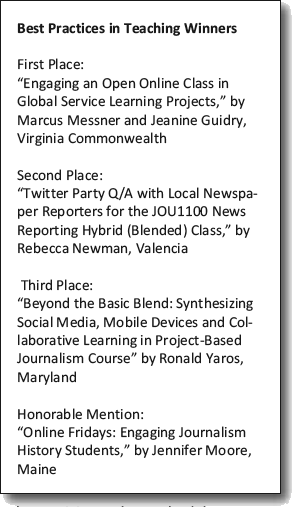Tips from the AEJMC Teaching Committee
The Device Du Jour Is Changing and Challenging
 By Amy Falkner
By Amy Falkner
AEJMC Standing Committee on Teaching
Senior Associate Dean for Academic Affairs
S.I. Newhouse School of Public Communications
Syracuse University
(Article courtesy of AEJMC News, September 2015 issue)
This is my last Teaching Tips column and I couldn’t be more jazzed. Not because I’m almost done — writing 800 words every once in awhile isn’t too taxing — but because of what I learned at the AEJMC San Francisco Conference. I am cycling off the Standing Committee on Teaching after two wonderful terms where I had an opportunity to think, discuss and judge great teaching. But, mostly, learn a lot.
To wit, I will share with you some great teaching resources and insights from the San Francisco Conference. If you are like me, your head was spinning when you got back with all the things you heard that you wanted to immediately incorporate into your fall courses. I’m writing this in mid-August but you are reading this in September and hopefully well on your way. If not, there is always time to adjust.
This dizzying effect may have taken hold while trying to follow #aejmc15 on Twitter during the conference. Yes, we were trending at one point. The good news is all those thousands of tweets are still available and — after you sort out the snapshots of the Golden Gate Bridge — very valuable. They are chock full of links to terrific graphics, articles and complete presentations as well as pithy food for thought on what we should be talking about in the classroom.
 One of your pit stops should also be the AEJMC website and the Teaching Resources link (under the “Resources” heading). There you will find the last nine Best Practices in Teaching booklets, including the latest on Best Practices in Teaching Online and Blended Learning.
One of your pit stops should also be the AEJMC website and the Teaching Resources link (under the “Resources” heading). There you will find the last nine Best Practices in Teaching booklets, including the latest on Best Practices in Teaching Online and Blended Learning.
The conference presentations by this year’s winners blew me away. Perhaps it is also because my school has just launched a new online master’s program and I have been wrestling this summer while planning my course with the what-do-I-teach-live versus recorded question. I am fortunate that the platform we are using is super interactive, but if you are at a school where that is not the case, the innovations of the winning professors (listed in box, right) will provide inspiration. There are tools you would expect — Facebook, Twitter, Instagram, Google Hangouts, WordPress, Blogger — with inventive means to an end.
I also heard about new ways of student learning from Ron Yaros, Maryland, one of the contest winners, who teaches using an app called Nearpod that his students access during live class on tablets or smartphones. No laptops allowed. On purpose. Ron has been testing how students best learn and some of that is to eliminate multitasking and distractions.
So maybe the device du jour is changing and that is part of our challenge — both in what we teach and how we teach it. Do we need to learn every new app and teach it in class? No, we’d lose our family, offline friends and probably our sanity if we invested every waking hour to that. But getting a handle on what new (and potentially free) tools our students can use related to analytics and, in particular, measuring social media was a theme I heard echoed in several panels and across disciplines.
Full disclosure: I am in the Advertising Division so my POV on POE (point of view on paid, owned, earned may differ from yours) but a fascinating panel on that topic put together by Patricia Mark, South Alabama, gathered quite a crowd at 8:15 a.m. on Friday of the conference. Penn State’s Marcia DiStaso made a great presentation titled “Data Science Changes in the Classroom” that included free analytical tools such as SimplyMeasured, Followerwonk, SumAll, Quintly, Cyfe and Keyhole that may (or may not) be familiar to you. Her slide on this has been tweeted and retweeted for good reason, including by me (@amyfalkner if you need it).
The last panel I will mention was led by (shameless plug alert) Newhouse’s Beth Egan on the topic of native advertising, which is Beth’s area of expertise and fertile ground for debate among the Ad, PR and journalist types in the room. The panel included Steve Rubel, EVP of Global Strategy and Insights at Edelman, who basically told the crowd that native is (and has been) happening for years, and too bad if we don’t like it. He also said publishing companies don’t matter much, mobile is the sun and all other platforms are planets, and that consumers will sort out the ethics of native advertising. That last snippet caused a kerfuffle. Is that the job of consumers? Shouldn’t we be teaching students the ethics of this?
So that trail eventually led to a discussion among the Teaching Committee to consider “teaching ethics in relation to emerging media” as our next teaching contest. It isn’t finessed or finalized yet, but look for the call explaining the next topic in the near future. Then mark your calendars for Aug. 4-7, 2016, in Minneapolis and be sure to add the Best Practices in Teaching session to your mobile app schedule. As for me, I will not need to attend another 7 a.m. meeting for this committee (the only happy part about my term ending), but I will definitely be at that session. #aejmc16 #loveteaching
 Print friendly
Print friendly






